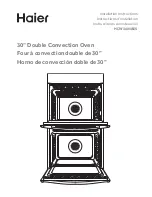
28
Tested for you in our cooking studio
Here you will find a selection of dishes and the ideal settings for
them. We will show you which type of heating and which
temperature are best suited for your dish. You can find
information about suitable accessories and the height at which
they should be inserted. There are also tips about cookware
and preparation methods.
Notes
■
The values in the table always apply to dishes placed into the
cooking compartment when it is cold and empty.
Only preheat the appliance if the table specifies that you
should do so. Do not line the accessories with greaseproof
paper until after they have been preheated.
■
The times specified in the tables are guidelines only. They will
depend on the quality and composition of the food.
■
Use the accessories supplied. Additional accessories may be
obtained as special accessories from specialist retailers or
from the after-sales service.
Before using the oven, remove any unnecessary accessories
and ovenware from the cooking compartment.
■
Always use oven gloves when taking hot accessories or
ovenware out of the cooking compartment.
Cakes and pastries
Baking on one level
When baking cakes, the best results can be achieved using
%
Top/bottom heating.
When baking with
:
3D hot air, use the following shelf heights
for the accessory:
■
Cakes in tins: level 2
■
Cakes on trays: level 3
Baking on two or more levels
Use
:
3D hot air.
Shelf heights for baking on 2 levels:
■
Universal pan: level 3
■
Baking tray: level 1
Shelf heights for baking on 3 levels:
■
Baking tray: level 5
■
Universal pan: level 3
■
Baking tray: level 1
Baking trays that are placed in the oven at the same time will
not necessarily be ready at the same time.
The tables show numerous suggestions for your dishes.
If you are baking with 3 cake/loaf tins at the same time, place
these on the wire racks as indicated in the picture.
Baking tins
It is best to use dark-coloured metal baking tins.
Baking times are increased when light-coloured baking tins
made of thin metal or glass dishes are used, and cakes do not
brown so evenly.
If you wish to use silicone baking tins, use the information and
recipes provided by the manufacturer as a guide. Silicone
baking tins are often smaller than normal tins. The amount of
mixture and recipe instructions may differ.
Tables
The tables show the ideal type of heating for the various cakes
and pastries. The temperature and baking time depend on the
amount and composition of the mixture. This is why
temperature ranges are given in the tables. You should try the
lower temperature first, since a lower temperature results in
more even browning. You can increase the temperature next
time if necessary.
If you preheat the oven, the baking time is shortened by 5 to 10
minutes.
Additional information can be found in the
Baking tips
section
following the tables.
Note:
Due to the high level of moisture when baking with
'
HydroBake, condensation can form on the inside window of the
oven. Open the oven door carefully, as hot steam will escape.
Types of heating:
■
:
= 3D hot air
■
%
= Top/bottom heating
■
'
= Hydro Baking
■
&
= Intensive heat
The meat is not cooked well enough or
is too well cooked.
Change the settings the next time. You will find information on this in the
Automatic pro-
grammes, Individual Settings
section.
Cakes in tins
Tin
Level
Type of
heating
Temperature
in °C
Cooking time
in minutes
Sponge cake, simple
Ring tin/cake tin
2
:
160-180
50-60
3 cake tins
3+1
:
140-160
60-80
Sponge cake, delicate
Ring tin/cake tin
2
%
150-170
60-70
Flan cake, sponge mixture
Flan tin
3
%
160-180
20-30
Delicate fruit flan, sponge
Springform/ring tin
2
%
160-180
50-60
Sponge base, 2 eggs (preheat)
Flan tin
2
'
150-170
20-30
Sponge flan, 6 eggs (preheat)
Springform cake tin
2
'
150-170
40-50
* Allow cakes to cool for approx. 20 minutes in the switched-off, closed oven
Summary of Contents for HB78GB.90W
Page 1: ... en Instruction manual HB78GB 90W Built in oven ...
Page 2: ......













































